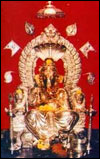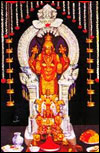(To know the cost of visiting temples please contact)
1. Gokarna (Mahabaleshwar)
 Gokarna is a town in the Uttara Kannada district of Karnataka state, India with a permanent population exceeding 25,000 (2001). It is a Hindu pilgrimage centre as well as a popular tourist destination. Gokarna is a temple town and is referred to in a number of Hindu historical literature pieces. The main deity is Lord Mahabhaleshwara, a form of the Hindu god Shiva. Around the town lie a number of beaches which serve as a major attraction for travellers.
Gokarna is a town in the Uttara Kannada district of Karnataka state, India with a permanent population exceeding 25,000 (2001). It is a Hindu pilgrimage centre as well as a popular tourist destination. Gokarna is a temple town and is referred to in a number of Hindu historical literature pieces. The main deity is Lord Mahabhaleshwara, a form of the Hindu god Shiva. Around the town lie a number of beaches which serve as a major attraction for travellers.
2. Idagundji (MahaGanapathi)
 Idagunji is a small place in Honnavara taluk, Uttar Kannada district, which has the famous Vinayaka temple. The temple is the main attraction at Idagunji, receiving more than 1 million devotees per year.
Idagunji is a small place in Honnavara taluk, Uttar Kannada district, which has the famous Vinayaka temple. The temple is the main attraction at Idagunji, receiving more than 1 million devotees per year.
Idagunji Devasthana is an ancient temple with a history of more than 1500 years.
3. Murudeshwar (Murdeshwar)
 Murudeshwara is a town in the Bhatkal Taluk of Uttara Kannada district in the state of Karnataka, India. “Murudeshwara” is another name of the Hindu god Shiva. Famous for the world’s second-tallest Shiva statue, Murudeshwara beach town lies on the coast of the Arabian Sea and is also famous for the Murudeshwara Temple.
Murudeshwara is a town in the Bhatkal Taluk of Uttara Kannada district in the state of Karnataka, India. “Murudeshwara” is another name of the Hindu god Shiva. Famous for the world’s second-tallest Shiva statue, Murudeshwara beach town lies on the coast of the Arabian Sea and is also famous for the Murudeshwara Temple.
4.Kollur (Mukambika)
 Kolluru or Kollur is a small temple-town situated about 37 kilometres (23 mi) from Kundapur Town, about 133 kilometres (83 mi) away from Mangalore City in Karnataka state in the southern part of India. This village lies at the foot of the Western Ghats and is famous for the Mookambika temple, a Hindu pilgrim center.
Kolluru or Kollur is a small temple-town situated about 37 kilometres (23 mi) from Kundapur Town, about 133 kilometres (83 mi) away from Mangalore City in Karnataka state in the southern part of India. This village lies at the foot of the Western Ghats and is famous for the Mookambika temple, a Hindu pilgrim center.
The goddess is called Mookambika as she is said to have slain the demon Mookasura. The goddess is described as in the form of a jyotirlinga incorporating both Shiva and Shakti.
5. Hattiangadi (Udhbhava Ganapathi)
 Hattiangadi is a village in Kundapura taluk of Udupi district. The village is famous for Siddivinayaka temple.
Hattiangadi is a village in Kundapura taluk of Udupi district. The village is famous for Siddivinayaka temple.
Hattiangadi, about 8 kms to the the northeast of Kundapur, which is famous for the ancient Siddhi Vinayaka Temple, also houses many other ancient Temples and Jaina Basadis. Gopalakrishna, Lokanatheshwara, Maraladevi, Shankaranarayan, Shivamunishwara, Ekantheshwara and Shaktharabrahma Temples are found here.
6. Anegudde (Udbhava Ganapathi)
 The Lord is called Siddhi Vinayaka or Sarva Siddhi Pradaayaka will grant and fulfill his devotees’ wishes. People believe in him that he will solve many of their problems and hence the place is known as “ Mukti Stalas” which means “Place where you can attain Salvation”. The garba griha or the main sanctum has the Lord Vinayaka in Chaturbuja (with 4 arms) in huge rock like structure covered in silver armour. Two arms are posing as “Varada Hasta” granting boons, and two hands indicate to attain salvation. There are many sculptures related to Bhargava Purana.
The Lord is called Siddhi Vinayaka or Sarva Siddhi Pradaayaka will grant and fulfill his devotees’ wishes. People believe in him that he will solve many of their problems and hence the place is known as “ Mukti Stalas” which means “Place where you can attain Salvation”. The garba griha or the main sanctum has the Lord Vinayaka in Chaturbuja (with 4 arms) in huge rock like structure covered in silver armour. Two arms are posing as “Varada Hasta” granting boons, and two hands indicate to attain salvation. There are many sculptures related to Bhargava Purana.
7. Udupi (Shree Krishna)
 Udupi is known for the Krishna Mutt (Temple of Lord Krishna) and also native place of the Vaishnavite saint Shri Madhvacharya who founded the Krishna Mutt in the 13th century.
Udupi is known for the Krishna Mutt (Temple of Lord Krishna) and also native place of the Vaishnavite saint Shri Madhvacharya who founded the Krishna Mutt in the 13th century.
According to folklore, there was a storm in the sea at Malpe. Shri Madhvacharya was on the shore at the time and saw a ship which was in trouble. He helped the ship reach the shore to safety. The sailors were very grateful to him and gave him deities of Lord Krishna and Lord Balarama. He did the pratishte (installation ceremony) of the deity of Lord Balarama near Malpe. This temple is known as Vadabhandeshwara. He brought the deity of Lord Krishna and did the pratishte at Udupi. This temple is known as Krishna Mutt.
8. Kateelu (Durga Parameshwari)
 Kateel or Kateelu is a temple town in the Dakshina Kannada district of Karnataka, India. This picturesque Temple abode of Goddess Durga Parameshwari located on the bank of river Nandini is about 26 k.m. from Mangalore, a place known for its serene nature and beautiful surroundings. The very Temple of Maatha Durga Parameshwari is located in the middle of the river Nandini. This holy place attracts thousands of devotees from all over. During rainy seasons, the river Nandini flows and gushes like a python. The nature surrounding the temple is a real treat to watch during this time. Pilgrims who visit the temple during the season do not feel like leaving because of the divinely charged Temple environs and its scenic beauty.
Kateel or Kateelu is a temple town in the Dakshina Kannada district of Karnataka, India. This picturesque Temple abode of Goddess Durga Parameshwari located on the bank of river Nandini is about 26 k.m. from Mangalore, a place known for its serene nature and beautiful surroundings. The very Temple of Maatha Durga Parameshwari is located in the middle of the river Nandini. This holy place attracts thousands of devotees from all over. During rainy seasons, the river Nandini flows and gushes like a python. The nature surrounding the temple is a real treat to watch during this time. Pilgrims who visit the temple during the season do not feel like leaving because of the divinely charged Temple environs and its scenic beauty.
9. Horanadu (Annapoorneshwari)
 “Sri kshetra Horanadu ” is situated on the banks of river Bhadra in a remote corner of chikamaglur dist., Karnataka, surrounded by the natural vegetation, forest, green lands, and natural beauty of the western Ghats. The great deity of adishakthyathmaka Sri Annapoorneshwari prathistapana was done by his holiness Agasthya Maharishi several centuries back. The hereditary Dharmakartharu of our family started 400 years back. Till the 5th Dharmakartharu, the temple was having a very small structure surrounded by full of natural vegetation and forest. Even then at least one or more people used to visit the temple, have pooja and were provided with free food {annaprasadam} and shelter and it is continued till date.
“Sri kshetra Horanadu ” is situated on the banks of river Bhadra in a remote corner of chikamaglur dist., Karnataka, surrounded by the natural vegetation, forest, green lands, and natural beauty of the western Ghats. The great deity of adishakthyathmaka Sri Annapoorneshwari prathistapana was done by his holiness Agasthya Maharishi several centuries back. The hereditary Dharmakartharu of our family started 400 years back. Till the 5th Dharmakartharu, the temple was having a very small structure surrounded by full of natural vegetation and forest. Even then at least one or more people used to visit the temple, have pooja and were provided with free food {annaprasadam} and shelter and it is continued till date.
10. Kukke Subramanya(Subramanya)
 Kukke Subramanya Hindu temple located in the village of Subramanya in the Sullia taluk of Dakshina Kannada District near Mangalore, Karnataka, India. The temple is one of the pristine pilgrimage locations in India. Here Lord Subrahmanya is worshipped as the lord of all serpents. The epics relate that the divine serpent Vasuki and other serpents found refuge under Lord Subrahmanya when threatened by Garuda. Pilgrims going to the temple have to cross the Kumaradhara River and take a holy dip in the river before entering the temple for their darshan holy viewing of the Lord.
Kukke Subramanya Hindu temple located in the village of Subramanya in the Sullia taluk of Dakshina Kannada District near Mangalore, Karnataka, India. The temple is one of the pristine pilgrimage locations in India. Here Lord Subrahmanya is worshipped as the lord of all serpents. The epics relate that the divine serpent Vasuki and other serpents found refuge under Lord Subrahmanya when threatened by Garuda. Pilgrims going to the temple have to cross the Kumaradhara River and take a holy dip in the river before entering the temple for their darshan holy viewing of the Lord.
The devotees enter the courtyard from the doorway at the back, and walk around to go before the deity. Between the sanctorum and the portico entrance, there is the Garuda pillar covered with silver. Devotees circumambulate this pillar. It is believed that this pillar was charmed and planted there to shield devotees from the poisonous flames streaming from the breath of Vasuki who resides inside. Beyond the pillar is the outer hall, the inner hall, and then the sanctorum of Sri Subrahmanya. At the center of sanctorum is a pedestal. On the upper dais stands the deity of Sri Subrahmanya and the deity of Vasuki and, at a somewhat lower level, the deity of Shesha. Ritual worship is offered to these deities every day.People from all over India visit with great devotion.
